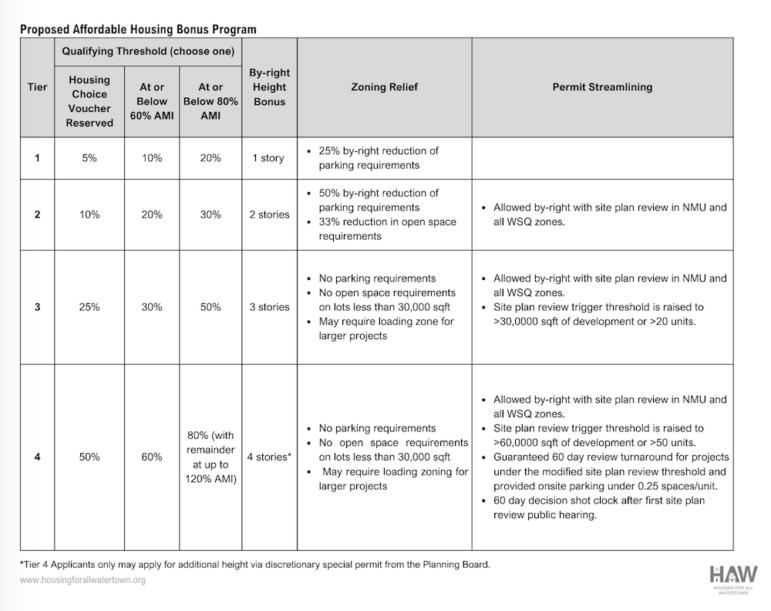
Throughout the Watertown Square planning process, one concern was raised above all others: the urgent need for more affordable housing.
We heard this again and again, in public remarks and written testimony, from residents across the political and socioeconomic spectrum. We have been calling for improvements to the Plan’s approach to affordable housing since the spring.
With the unanimous passage of the Watertown Square Area Plan and the release of a draft zoning proposal from our city planners, Watertown’s elected officials now have an opportunity to address the primary concern of its residents. They have a directive to implement policies that can effectively and rapidly generate new affordable housing.
So how do we successfully encourage affordable housing development? How do we make sure affordable housing developers can compete?
First, you make it less difficult and less expensive to build new homes. The Watertown Square Area Plan is a big step forward in lowering the barriers to new housing in our community.
Second, you incentivize affordable housing. This is where we fall short. The current plan allows a single additional floor for a project where at least 50% of units are reserved for those making less than 80 percent of the area median income (AMI), and it allows two additional floors for a project where at least 50 percent of units on average are reserved for those making less than 60 percent of the AMI.
This is well intentioned, but how does this stack up against communities in the area? Not especially well. The threshold for a one-story height bonus in Watertown Square is twice what it is in Newton and more than three times what it is in Chelsea, while our two-story bonus threshold is more than ten times higher than Medford’s.
Moreover, our current height bonus framework offers just a single threshold, creating a “cliff effect.” A project at 49 percent affordable units gets no bonus, where a project at 50 percent gets the same bonus as a project with 100 percent affordable units. There is no incentive here for a project to add affordability between the 15 percent inclusionary zoning requirements and the 50 percent bonus threshold, and no further incentive for a project to go above 50 percent affordable.
The Watertown Square Area Plan should have tiered incentives across the entire spectrum of affordability levels, from primarily market rate to 100 percent affordable. It should also include specific incentives to preserve units for Housing Choice Voucher (Section 8) holders.
Drawing on a review of best practices from area communities and across the country, the Housing for All Watertown zoning and affordability working groups have drafted the following framework to improve the incentives in the Watertown Square Area Plan:

You can read more about this proposal, as well as our comparison of Watertown’s affordability bonuses to other communities, at the HAW website.
Watertown’s residents have demanded, with a clear and unified voice, that our elected officials address the affordable housing crisis, which has driven so many neighbors, friends, and families out of our community in recent years. The incentive structure outlined here offers a path forward.
Together, we can ensure that there is housing for residents at every income level and stage of life.
Housing for All Watertown, Steering Committee
Rita Colafella, Sam Ghilardi, Daniel Pritchard, Josh Rosmarin, Jacky van Leeuwen
“Throughout the Watertown Square planning process, one concern was raised above all others: the urgent need for more affordable housing” – Your intentions are admirable but, more housing comes at a cost for those of us who would like not to be crowded out by more and more people. I am finding that the transition from a town to a city is making Watertown Less livable. the massive increase in housing and people coming into the area has been a boon only for those who own real estate but not for those who rent. Making the area more crowded isn’t going to improve rent prices or quality of life.
More housing does not equal affordable housing. Building new structures for business and housing is expensive. That’s why areas that build new business and housing see rent increases.